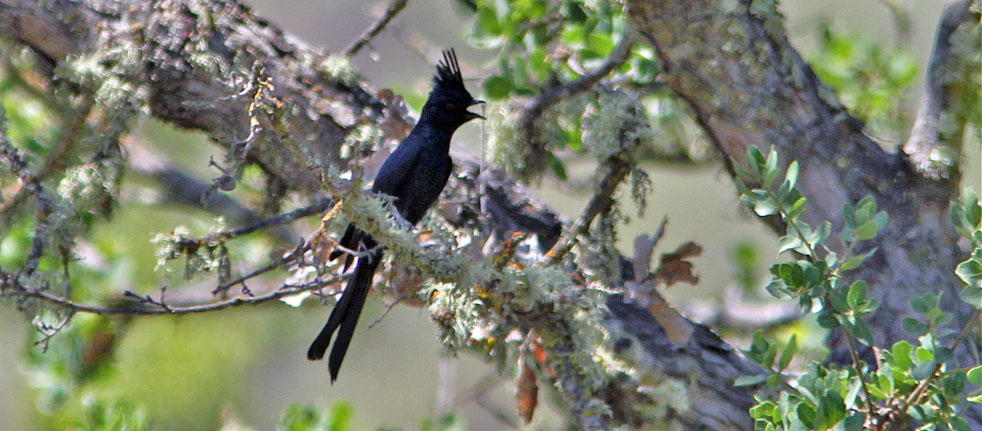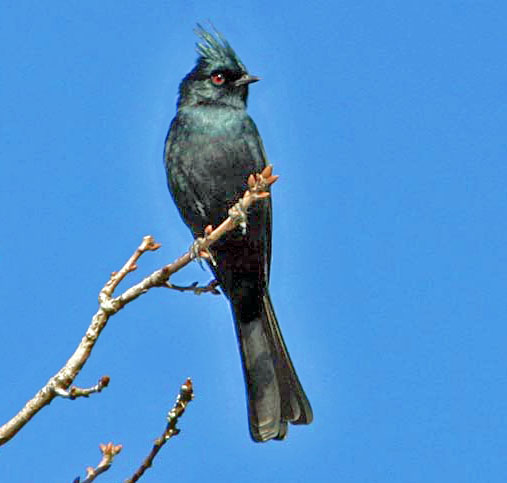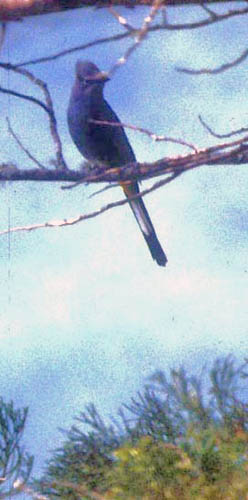
a web page by Don Roberson |
SILKY-FLYCATCHERS Ptilogonatidae |
|||
|
|||
Plumage of Silky-flycatchers range from silky black (male Phainopepla) to gray to yellow (depending on the species) but always with a lovely sleek sheen to it. All species fly-catch for insects — mostly taken in the air — but some are also heavily dependent on berries. Phainopepla, for example, is strongly associated with mistletoe berries in the oak woodlands of central California. Yet in southern California and Arizona it is a desert species in lightly-wooded riparian washes. |
|||
 |
|||
 |
|||
We generally think of silky-flycatchers as resident species, but there can be substantial movements. In southern California, some Phainopepla populations move between deserts — where they nest early in the season — to the mountains or coastal woods — where they re-nest later in the season (Walsberg 1977. This is a fascinating scenario that needs further study; does something similar happen in the nomadic populations of coastal central California? This family also cares for its young quite a long time. In some species the downy young remain in the nest for 18-25 days, a surprisingly long time for a open-nesting passerine bird. Vagrants occur from time to time, including this immature Phainopepla (right) in my home town of Pacific Grove, Monterey County, California, in fall 2001. Immatures resemble females in plumage. There are currently only records for Phainopepla on the Monterey Peninsula: this one from 23 Sep 2001, and another 14 years later on 24 Sep 2015. These mid-September dates may suggest that the "vagrancy window" for this species as about the third week of September. Even though it is now 50 years ago, I still recall my first Phainopepla well because it was such a striking bird. It was my first trip to Morongo Valley, southern California, in March 1972. Just as I saw a male Phainopepla, a biologist working for Charles Sibley appeared from out of the bushes with a small Phainopepla egg! He was collecting eggs for an egg-white protein analysis project to help figure out the relationship of this enigmatic bird. Sibley worked with egg-white proteins before moving to the DNA-DNA hybridization technique that was used for the results published in Sibley & Monroe (1990). A further detail about that egg-white protein project was discussed in Chu (2005). It turns out that John James Audubon first described Townsend's Solitaire Myadestes townsendi in 1838, he thought it was a silky-flycatcher and placed it in the genus "Ptiliogony's" [sic]. It wasn't until 1864 that S.F. Baird suggested the solitaire had affinities to thrushes, and subsequently Myadestes was moved to the Turdidae. Yet over a hundred years later, Sibley (1973) advocated the inclusion of Myadestes in the Ptilogonatidae "on the basis of electrophoretic patterns of egg-white proteins!" And strangely, like Forrest Gump, I was there. |
|||
|
|||
Although silky-flycatchers are a distinctive group, DNA hybridization evidence (Sibley & Ahlquist 1990) indicated that they are most closely related to waxwings, just had been thought to be true long before biochemical studies (Chu 2005). This relationship was confirmed again by molecular studies this century. Ptilogonatidae is part of the bombycilloid radiation of oscine passerines (Winkler et al. 2015). The silky-flycatchers are likely sister to the waxwings [Bombycillidae] but it is possible that the nearest relatives were the recently extinct Mohoidae of Hawaii (Fleischer et al. 2008). |
|||
Photos: The first photo of a male Phainopepla Phainopepla nitens was along Hunt Rd., Calaveras Co., California, on 6 Feb 2005; the calling male was along Arroyo Seco Rd., Monterey Co., California, on 28 Apr 2103. The in-flight female Phainopepla was along Shirttail Canyon Rd., Monterey Co., on 20 Mar 2015; the vagrant immature was in Pacific Grove, Monterey Co., on 23 Sep 2001. The Long-tailed Silky-flycatcher Ptilogonys caudatus was at Savegre, Costa Rica, on 24 Dec 1987. The first Gray Silky-Flycatcher Ptilogonys cinereus was within its expected range among pine-oak woodlands above Paval, Chiapas, Mexico, in April 1986; the second Gray Silky-Flycatcher (a small inset, digitized from slide) was well out-of-range in the Cleveland Nat'l Forest, Orange Co., California, on 13 Feb 1999. All photos © Don Roberson; all rights reserved. Bibliographic note: There is no "family book" per se, but a fine introduction to this family, with some good photos, is in Chu (2005). Literature cited:
|
 The Silky-Flycatchers are a small family of delicate, long-tailed, thrush-sized birds that inhabit woodlands from the southwestern United States south to the mountains of western Panama. They are essentially a Middle American family. Three of the four species are crested, including the northernmost representative, Phainopepla (males, left and below).
The Silky-Flycatchers are a small family of delicate, long-tailed, thrush-sized birds that inhabit woodlands from the southwestern United States south to the mountains of western Panama. They are essentially a Middle American family. Three of the four species are crested, including the northernmost representative, Phainopepla (males, left and below).  All silky-flycatchers have sexual dimorphism but most strikingly in Phainopepla. Males are rich silky-black with huge white panels in the primaries; females are mostly grayish, but also show the white primary-panel in flight (female Phainopepla, above). The English name "Phainopepla" comes from the Greek, and means "shining robe." As it is a Greek name, some contend that all vowels must be pronounced. Thus the name should be said "Fay-eye-no-pep-la." Ever since I heard that theory back in the 1970s, I've called this bird "Fay-eye-no-pep-la," but no one else seems do so. For the rest of the world, it is just "Fain-o-pep-la." I suggest trying it "my" way. It has a nice ring to it.
All silky-flycatchers have sexual dimorphism but most strikingly in Phainopepla. Males are rich silky-black with huge white panels in the primaries; females are mostly grayish, but also show the white primary-panel in flight (female Phainopepla, above). The English name "Phainopepla" comes from the Greek, and means "shining robe." As it is a Greek name, some contend that all vowels must be pronounced. Thus the name should be said "Fay-eye-no-pep-la." Ever since I heard that theory back in the 1970s, I've called this bird "Fay-eye-no-pep-la," but no one else seems do so. For the rest of the world, it is just "Fain-o-pep-la." I suggest trying it "my" way. It has a nice ring to it. 

 Because the movements of the Ptilogonatidae are not well understood, the occurrence of a Gray Silky-Flycatcher (right) in coastal southern California became controversial. Although this one was in good montane habitat, and apparently well away from presumed sources of captivity, the California rarities committee eventually decided they couldn't decide, and placed the record in a "supplemental list" limbo. [Incidentally, Herb Clarke's and Brian Small's photos of this bird were published by Chu (2005) "as a vagrant to the USA" (or at least I think it was this bird, mistakenly attributed to "San Diego County.)"]
Because the movements of the Ptilogonatidae are not well understood, the occurrence of a Gray Silky-Flycatcher (right) in coastal southern California became controversial. Although this one was in good montane habitat, and apparently well away from presumed sources of captivity, the California rarities committee eventually decided they couldn't decide, and placed the record in a "supplemental list" limbo. [Incidentally, Herb Clarke's and Brian Small's photos of this bird were published by Chu (2005) "as a vagrant to the USA" (or at least I think it was this bird, mistakenly attributed to "San Diego County.)"]